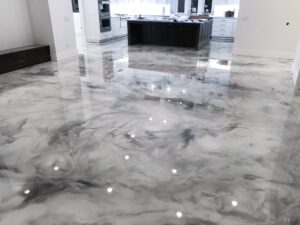Flooring installation is a complex task that takes a lot of preparation. The more you prepare, the better it will go. One of the first things you must do is remove the existing floor and all baseboards. This will give you a smooth and level subfloor to work with.

Preparation
Preparation of the subfloor is an important phase in the floor installation process. It ensures that the flooring system will be properly adhered to the concrete substrate and protect it from stains and damage.
The substrate must be dry and relatively smooth. It must also be free from previous surface applications that may affect the adhesive bond, stain or impede the appearance of the new flooring.
A good way to determine the cost of this work is to estimate the amount of time that will be needed for it and then add the costs up for labor, materials and the cost of any equipment needed to accomplish the task.
For instance, if the customer is installing laminate flooring over carpet, then the cost of levelling and patching the subfloor will likely be quite high. This is because most carpets have a pretty rough surface, and it takes some time to get them to a smooth and flat surface.
Underlayment
Underlayment is an important part of the floor installation process. It reduces noise and mud from footsteps, provides extra cushioning for hardwood floors, and helps keep the floor’s temperature stable.
The underlayment you choose will depend on the type of flooring you plan to install and your local building codes. A flooring expert will help you decide on the right underlayment for your project.
Plywood: A sheet of 4-by-8-foot A/C grade plywood cut to size is a good underlayment for dry applications (under laminate, hardwood, or engineered wood). This kind of plywood has one smooth face and a rough side that can be used for the bottom of the floor.
Foam: Standard foam underlayment comes in rolls and is easy to install. It has a thicker profile than most underlayment materials, helping to minimize subfloor imperfections and improving insulation value.
Felt: Felt underlayment is also available in sheets or rolls and offers excellent soundproofing. It is thicker than most types, and some brands have a waterproof barrier on one side for use over concrete.
Installation
Installing a floor is a major undertaking that requires the skills and equipment of professionals. They know how to take proper precautions during the acclimatization process, use the right materials and adhesives for specific flooring types and keep the subfloor moisture levels in check.
Before installing a new hardwood or laminate floor, it is essential to remove your old floors and any underlayment that needs to be replaced. These steps will help the installation team get started quickly and avoid any unnecessary delays.
Once the old floors are removed, they will set up the new underlayment and prepare your room for installation. This phase of the flooring installation process can take a few hours or days depending on the size and type of floors that you are installing.
Once the floors are in place, the installation team will complete a post-installation inspection. This is a good time to ask questions about the project, voice any concerns you may have and give your contractor feedback.
Finishing
Floor finishing is a key part of the floor installation process, and can have a dramatic impact on the longevity of your hardwood floors. It protects the wood and helps to create a hard, dense barrier between it and the environment.
A quality floor finish is made of a blend of volatile and non-volatile ingredients. The volatile ingredients help to form a film, dry and cure while the non-volatile ingredients remain on the surface of the wood and make it water and detergent resistant.
Start by laying down the first plank, spacing it about 3/4 inch away from the wall (as directed by the manufacturer). Use spacers to maintain this gap.
Lay the second board in line with the first and repeat until all the boards are installed. Once you have all the floor boards in place, abut them end to end, drilling pilot holes and securing them with face-driven nails.
When laying laminate, it is important to take special care at the beginning of the installation to avoid warping. During this phase, you must acclimate the laminate to humidity.
